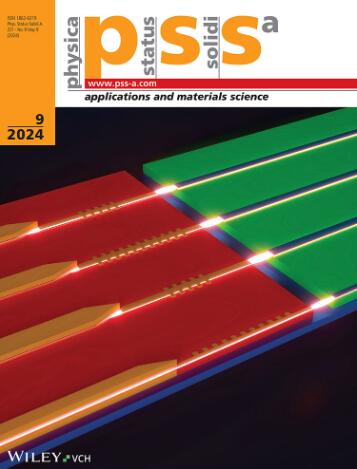利用二硫化钨电子传输层和三氧化钼空穴传输层提高 SnS 太阳能电池的性能
IF 1.9
4区 材料科学
Q3 MATERIALS SCIENCE, MULTIDISCIPLINARY
Physica Status Solidi A-applications and Materials Science
Pub Date : 2024-09-17
DOI:10.1002/pssa.202400547
引用次数: 0
摘要
本文设计了一种新型异质结光伏(PV)器件,将三氧化钼(MoO3)作为空穴传输层(HTL),硫化锡(SnS)作为吸收层,二硫化钨(WS2)作为电子传输层(ETL)。利用广泛使用的太阳能电池模拟器(SCAPS-1D)研究了所提出的 Ni/MoO3/SnS/WS2/FTO/Al 薄膜太阳能电池(TFSC)的光伏输出。研究发现,SnS TFSC 在 SnS/WS2 和 MoO3/SnS 界面均具有合适的带排列,其光电转换效率优于传统的 TFSC。为了优化材料特性,我们通过改变材料厚度、掺杂浓度、块状和界面缺陷密度、工作温度和背触点功函数等影响因素,计算了开路电压(Voc)、短路电流密度(Jsc)、填充因子(FF)和效率等性能参数。当 MoO3 HTL 的优化厚度为 0.1 μm 和 SnS 吸收体的优化厚度为 1.0 μm 时,所建议的 TFSC 的效率估计为 30.42%,Voc 为 1.02 V,Jsc 为 34.38 mA cm-2,FF 为 87.04%。这些结果表明,无毒的 MoO3 和 WS2 材料可作为 HTL 和 ETL 应用于廉价、高效和环保的 SnS 基光伏电池。本文章由计算机程序翻译,如有差异,请以英文原文为准。
Performance Enhancement of SnS Solar Cell with Tungsten Disulfide Electron Transport Layer and Molybdenum Trioxide Hole Transport Layer
Herein, a new heterojunction photovoltaic (PV) device is designed by incorporating molybdenum trioxide (MoO3 ) as a hole transport layer (HTL), tin sulfide (SnS) as an absorber, and tungsten disulfide (WS2 ) as an electron transport layer (ETL). The PV outputs of the proposed thin‐film solar cell (TFSC) of Ni/MoO3 /SnS/WS2 /FTO/Al are investigated using the widely used solar cell simulator (SCAPS‐1D). It is found that the SnS TFSC with suitable band alignments at both the SnS/WS2 and MoO3 /SnS interfaces gives better photoconversion efficiency than the conventional one. To optimize the material properties, the performance parameters, including open‐circuit voltage (V oc ), short‐circuit current density (J sc ), fill factor (FF), and efficiency, have been calculated by varying the influences of the material's thickness, doping concentration, bulk and interface defect densities, operational temperature, and work function of back‐contact. At optimized thicknesses of 0.1 μm for MoO3 HTL and 1.0 μm for SnS absorber, the efficiency is estimated to be 30.42% with V oc of 1.02 V, J sc of 34.38 mA cm−2 , and FF of 87.04% for the suggested TFSC. These outcomes imply that the nontoxic MoO3 and WS2 materials can be applied as HTL and ETL into the inexpensive, highly efficient, and environmentally friendly SnS‐based PV cell.
求助全文
通过发布文献求助,成功后即可免费获取论文全文。
去求助
来源期刊
CiteScore
3.70
自引率
5.00%
发文量
393
审稿时长
2 months
期刊介绍:
The physica status solidi (pss) journal group is devoted to the thorough peer review and the rapid publication of new and important results in all fields of solid state and materials physics, from basic science to applications and devices. Among the largest and most established international publications, the pss journals publish reviews, letters and original articles, as regular content as well as in special issues and topical sections.

 求助内容:
求助内容: 应助结果提醒方式:
应助结果提醒方式:


